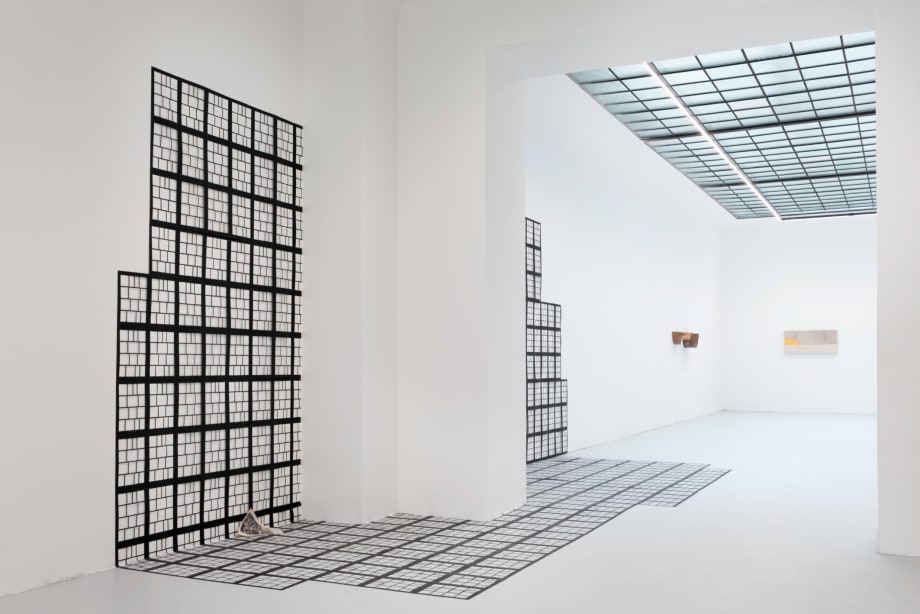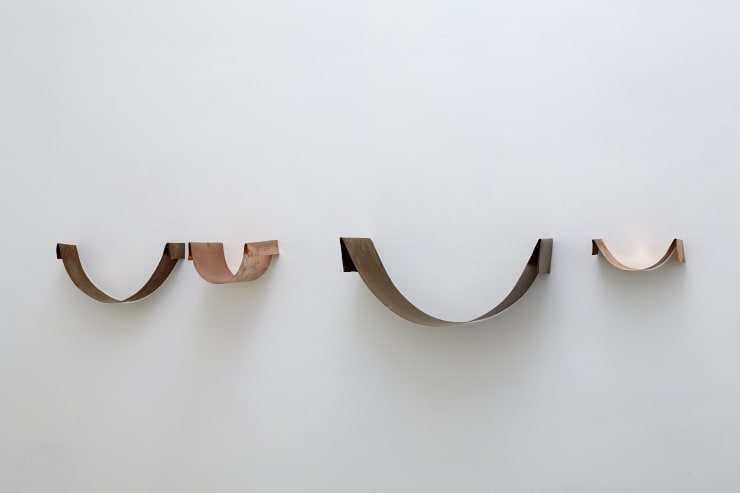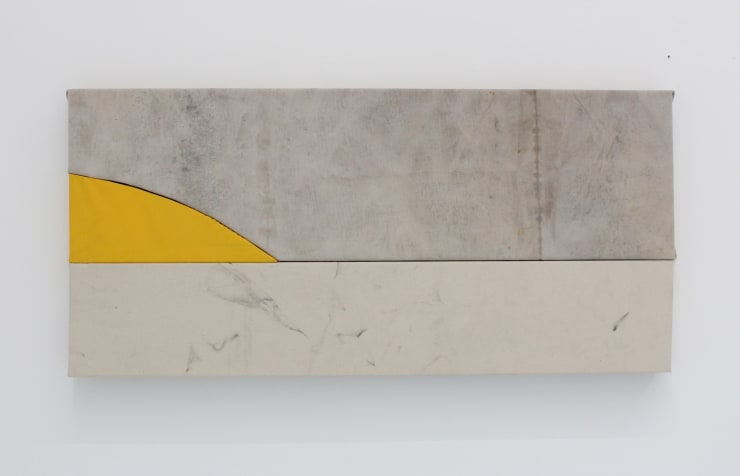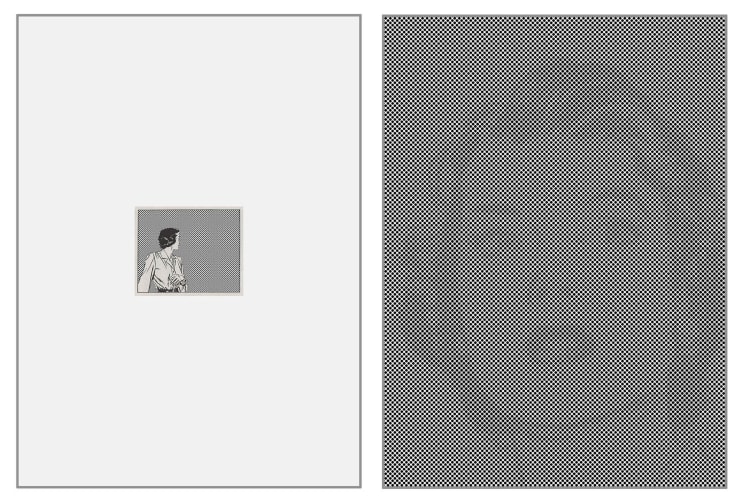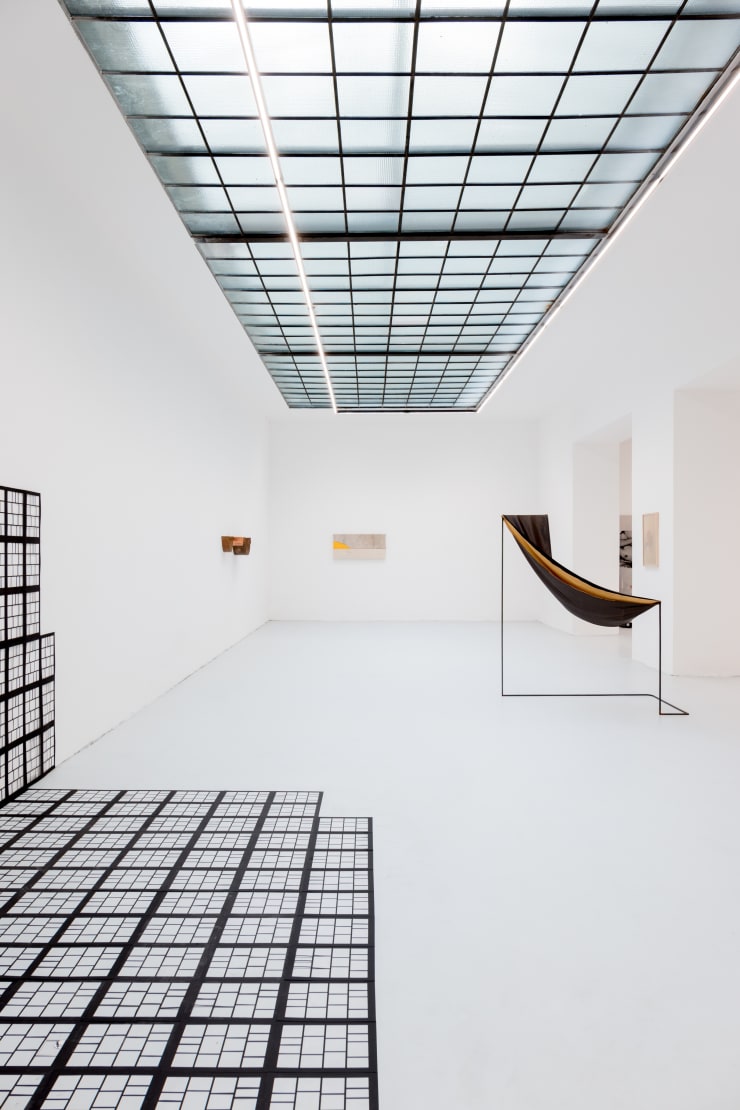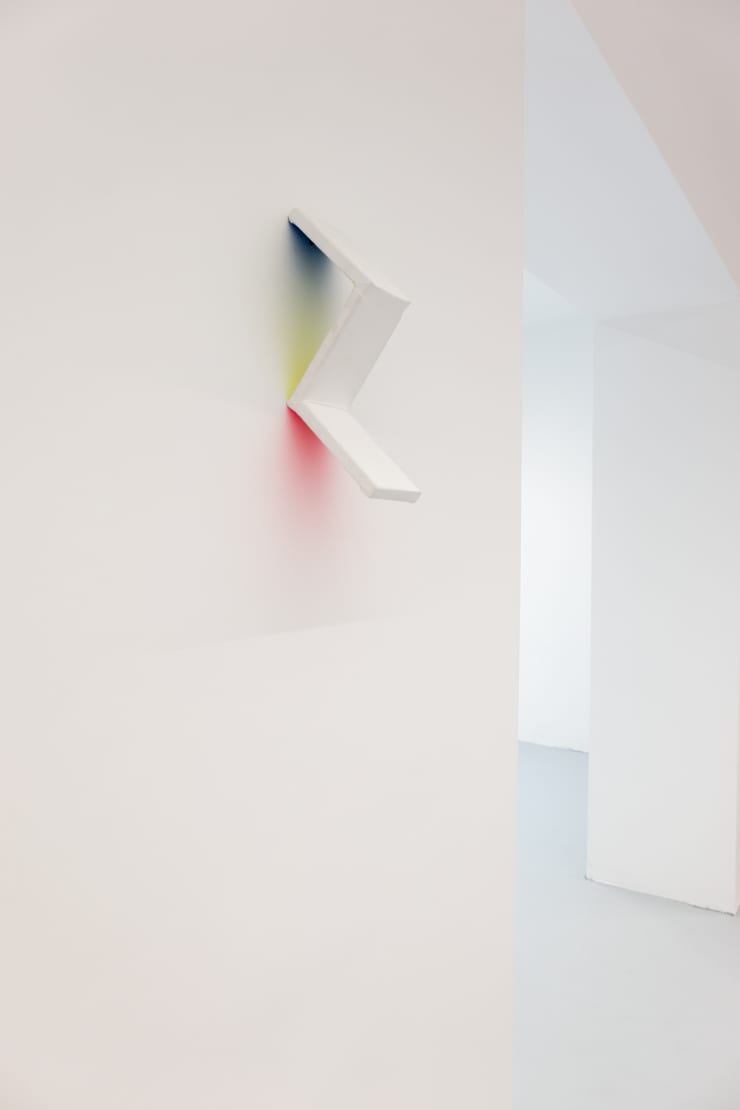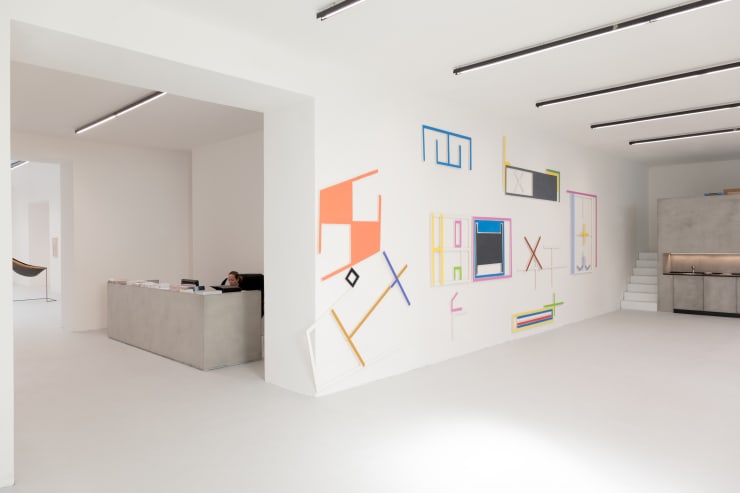Group Exhibition I If Walls Are Trembling
Artists:
Athanasios Argianas / Alex Hoda / Alina Kunitsyna/ James English Leary
Lindsay Lawson / Grear Patterson / Hannah Perry / Andres Ramirez Gaviria
Patric Sandri / Marco Stanke / Pier Stockholm / Martin Vitaliti
Painting has been declared dead many times before. This may be due to the traditional definition and the aesthetic conditions that have determined its main characteristics for centuries. Nonetheless each attempted lethal blow at painting seems to have only increased its popularity. The apparent limitations make painting susceptible for attack, the static shapes and flat stretcher frames are emblematic of boundaries and stagnation. And although this particular guideline has been continuously undermined or rendered obsolete, the fixed position on the wall is still of great significance to date, as it categorically distinguishes painting from object or installation. Sculpture, on the other hand is traditionally presented on a pedestal. So what role do the base, the walls, the stretcher frames and the pedestal play? The group exhibition "If Walls Are Trembling" at Galerie Lisa Kandlhofer shows twelve artistic positions, manipulating the traditional relationship of art and its display in various media.
-
 Hannah PerryI'd be lying if I said I was ok, 2016Triptych, Lacquer and silkscreen print on aluminium board182,88 x 121,92 x 3,81 cm
Hannah PerryI'd be lying if I said I was ok, 2016Triptych, Lacquer and silkscreen print on aluminium board182,88 x 121,92 x 3,81 cm -

Hannah Perry,
Installation View -

Andres Ramirez Gaviria, Between Forms of Representation and Interpretation, 2015,
-
 Athanasios ArgianasLyrical Machine, 2014
Athanasios ArgianasLyrical Machine, 2014 -
 Athanasios Argianas8 Relative Ratios, 2014
Athanasios Argianas8 Relative Ratios, 2014 -
 Alex HodaMundhöhe (Mouth Level), 2012White marbleheight 50 cmEdition 1 von 3
Alex HodaMundhöhe (Mouth Level), 2012White marbleheight 50 cmEdition 1 von 3 -

Marco Stanke,
"Tonträger", 2016 -
 Grear PattersonVitamin D, Thank You in Advance, 2016World War II cloth, beach umbrella, firework exhaust on canvas48.3 x 104.1 cm
Grear PattersonVitamin D, Thank You in Advance, 2016World War II cloth, beach umbrella, firework exhaust on canvas48.3 x 104.1 cm
19 x 41 in -
 Martin VitalitiBatman GiroCollage on inkjet print27 x 18 cm
Martin VitalitiBatman GiroCollage on inkjet print27 x 18 cm -
 Martin Vitaliti# 108/XXII, 2015Punched out original frame on inkjet print33 x 53 cm (33 x 24 cm each)
Martin Vitaliti# 108/XXII, 2015Punched out original frame on inkjet print33 x 53 cm (33 x 24 cm each) -
 Grear PattersonSunglasses and Sex, 2016Firework exhaust on canvas, last supper table cloth205.7 x 205.7 cm
Grear PattersonSunglasses and Sex, 2016Firework exhaust on canvas, last supper table cloth205.7 x 205.7 cm
81 x 81 in -
 James English LearyLove Getting Bludgeoned by Work, 2016Acrylic on Linen and Canvas167.6 x 185.4 cm
James English LearyLove Getting Bludgeoned by Work, 2016Acrylic on Linen and Canvas167.6 x 185.4 cm
66 x 73 " -
 Lindsay LawsonDas Ding, 2010HD Video 3:393+1AP
Lindsay LawsonDas Ding, 2010HD Video 3:393+1AP -
 Lindsay LawsonWrangler, 2015jean, short, packing peanuts, charcoal, wire mesh,plaster,pigment, resin81 x 19 cm
Lindsay LawsonWrangler, 2015jean, short, packing peanuts, charcoal, wire mesh,plaster,pigment, resin81 x 19 cm
PRESS RELEASE
23 Sept. - 20 Oct. 2016
IF WALLS ARE TREMBLING
Alex Hoda | Alina Kunitsyna | Andrés Ramírez Gaviria | Athanasios Argianas | Lindsay Lawson | James English Leary | Grear Patterson | Hannah Perry | Patric Sandri | Marco Stanke | Pier Stockholm | Martín Vitaliti
Wir freuen uns die Gruppenausstellung „If Walls Are Trembling“ zur Neueröffnung der Galerie Lisa Kandlhofer (ehemals Lisabird Contemporary) ankündigen zu dürfen.
Der Malerei wird immer wieder ihr eigener Tod nachgesagt. Ein Grund dafür liegt in ihrer konservativen Definition und ihren ästhetischen Bedingungen, die sie zwar seit Jahrhunderten aauf ihre Hauptmerkmale festlegen, gleichwohl aber zur populärsten Gattung der Kunst machten. Ihre statischen Formen und flachen Keilrahmen stehen emblematisch für Grenzen, für Stillstand. Obgleich diese Richtlinie regelmäßig untergraben und für obsolet erklärt wird, kommt speziell der fixierten Position an der Wand bis heute eine große Bedeutung zu, weil sie die Malerei kategorisch vom Objekt und der Installation unterscheidet. Umgekehrt verhält es sich mit der Skulptur, die klassischerweise auf einem Sockel präsentiert wird. Welche Rolle spielen also die Träger, die Wände, Keilrahmen und Sockel? Die Gruppenausstellung „If Walls Are Trembling“ in der Galerie Lisa Kandlhofer zeigt zwölf künstlerische Positionen, die das traditionelle Verhältnis von Kunst und seiner Schaufläche mit unterschiedlichen Medien manipulieren.
Einige Künstler gehen mit ihren Arbeiten etwa gezielt gegen das klassische Format der Malerei vor und testen deren Grenzen bis zur Objekthaftigkeit aus. So formen die beiden Amerikaner James English Leary und Grear Patterson Rahmen und Leinwände jeweils zu
figurativen Wand-Objekten und brechen dabei mit dem traditionellen Rechteck. Während Learys „Shaped Canvases“ die Comic-Ästhetik von stilisierten Händen oder Mündern aufgreifen, spielt Pattersons fortwährende Smiley-Serie, die jeweils aus drei Leinwänden zwei Augen und einen Mund mimt, mit Emoticons der populären Digitalkommunikation. Die Arbeiten des deutschen Künstlers Marco Stanke bleiben abstrakt und testen innerhalb eines geometrischen Formenvokabulars ebenfalls die Grenzen der rechteckigen Malerei aus. Seine „Teile“, die weniger als Malereien sondern vielmehr als einzelne Objekte auftreten, verhalten sich wie kleine, unterschiedliche Puzzleteile zueinander und formen in der Zusammenschau auf einer Wand das sogenannte „Kollektiv“. Der Schweizer Patric Sandri hingegen lässt die Oberflächen minimalistischer Leinwände aufklaffen und transformiert so den Riss zum Motiv.
Bei einigen der ausgestellten Arbeiten werden den eigentlichen Bühnen der Narration, also der Leinwand und dem Keilrahmen, skulpturale Qualitäten zugeschrieben, die wiederum die Funktion der Wand, als notwendiger Träger, in Frage stellen. Das trifft ganz besonders auf die minimalistischen Zeichnungen und Fotografien des peruanischen und in Paris lebenden Künstlers Pier Stockholm zu, der Mobiliar oder Architektur aus seinem Arbeitsalltag und Designelemente, etwa von Fahnen, in seine Arbeiten integriert. In den Materialangaben der zunächst elegant wirkenden Vasen-Objekte der Amerikanerin Lindsay Lawson finden sich gleich mehrere alltägliche und oft kuriose Substanzen: Pullover, Pflaster, Ballons, Chipstüten oder auch Kokosnüsse vermischt Lawson mit Pigment und Lack, und formt sie schließlich zu soliden Skulpturen, die auf Sockeln präsentiert werden. Sowohl die Vasen als auch die abstrakten Stein-Objekte des Engländers Alex Hoda stellen die gesellschaftlichen Wertvorstellungen von Kunstobjekten und deren Präsentationsformat in Frage. Denn obgleich Hodas Serie „Hostage Sculptures“ aus exquisitem Material besteht, liegt der Form ausschließlich ein vom Künstler zerkauter Nikotinkaugummi zugrunde, den er erst mit einem 3D Drucker vergrößert und dann in Italien in Marmor meißeln lässt.
Auch der kolumbianische Künstler Andrés Ramírez Gaviria rekontextualisiert ein Alltagsobjekt – die Leuchtröhre – zum Material seiner Installationen. Die „modal.patterns“ übersetzen als Informationsmatrix Sätze und einzelne Wörter, indem sie kodierte Daten syntaktischer Bestandteile blinkend visualisieren. Dieses abstrakte Übersetzen, das vielmehr
nach einem poetischen Ausdruck als nach wirklicher Verständlichkeit strebt, ist ebenfalls zentral für die Objekte des Griechen Athanasios Argianas. Dessen Arbeiten, wie zum Beispiel die „Lyrical Machine“, übertragen komplexe Musikkompositionen in stumme, filigrane Gebilde, die den Noten einen skulpturalen Körper verleihen.
Dreidimensionale Qualitäten, das Ausbrechen aus dem Bildrahmen, finden sich auch in den Tuschezeichnungen der russischen Künstlerin Alina Kunitsyna. Während sich die von ihr gemalten Figuren wie Körper aus dem Bild hervorheben, fliehen die Comic-Superhelden des argentinischen Künstlers Martín Vitaliti von ihrer Seite davon und durchstoßen, scheinbar mit aller Kraft, den Rahmen in dem sich normalerweise ihre Aktionen ausschließlich abspielen. Vitalitis Bodeninstallation greift diesen Gedanken konzentriert auf und lässt gleich dutzende weiße Bilder aus ihren schwarzen Rahmen fallen. Die Engländerin Hannah Perry greift mit ihrer multi-medialen Installation schließlich mehrere Ebenen der Grenzüberschreitung auf. Wiederholende Rhythmen, dunkle Gänge und Collagen an den Wänden kreieren Atmosphären, die – irgendwo zwischen einem Technoclub und Lifestyle Magazin geschönten Körpern – dem White Cube der Ausstellungsfläche eine kühle und selbstbewusste Sexualität entgegensetzen.
In der Ausstellung „If Walls Are Trembling“ gilt diese Art von Konfrontation – das grenzüberschreitende Verlassen fixierter Positionen – sowohl der Wand, als auch den Sockeln, Leinwänden und Keilrahmen. Sie werden nicht verabschiedet, sondern neu interpretiert, umfunktioniert oder ganz einfach als Teil des Kunstwerks deklariert.
Painting has been declared dead many times before. This may be due to the traditional definition and the aesthetic conditions that have determined its main characteristics for centuries. Nonetheless each attempted lethal blow at painting seems to have only increased its popularity. The apparent limitations make painting susceptible for attack, the static shapes and flat stretcher frames are emblematic of boundaries and stagnation. And although this particular guideline has been continuously undermined or rendered obsolete, the fixed position on the wall is still of great significance to date, as it categorically distinguishes painting from object or installation. Sculpture, on the other hand is traditionally presented on a pedestal. So what role do the base, the walls, the stretcher frames and the pedestal play? The group exhibition "If Walls Are Trembling" at Galerie Lisa Kandlhofer shows twelve artistic positions, manipulating the traditional relationship of art and its display in various media.
Some of the artists challenge especially the traditional format of painting and probe its boundaries up to objecthood. The two Americans James English Leary and Grear Patterson turn the stretcher frames and canvasses into figurative wall objects and break with the tradition of the rectangle. While Leary’s “Shaped Canvasses” revisit the cartoon aesthetic of stylized hands and mouths, Patterson’s smiley series – consisting of three canvasses representing two eyes and a mouth – plays with the popular emoticons of the current digital communication. The works of Marco Stanke remain abstract, and within a geometric vocabulary they explore the limits of the painting’s rectangular shape as well. His “Parts” appear as objects rather than paintings, interrelate like small pieces of a puzzle, and form in their synopsis on the wall the so called “Collective”. The Swiss Patric Sandri on the other hand lets the surfaces of minimalistic canvasses burst open and thus transforms a tear into a motive.
In the case of some of the exhibited works the actual platforms of narration, the canvasses and the stretcher frames, are attributed with sculptural qualities, which in turn question the purpose of the wall as a necessary basis. This applies particularly to the minimalistic drawings and photographs of Pier Stockholm, a Peruvian artist who lives in Paris and who integrates
furniture or architecture from his work routine as well as design elements, e.g. from flags, into his work. In the specifications of the material used for the initially elegant looking vase- objects of the American Lindsay Lawson many everyday and occasionally even very peculiar substances
can be found: Lawson mixes sweaters, balloons, bags of chips or even coconuts with pigments and varnish and moulds them into solid sculptures, which are displayed on pedestals. The vases as well as the abstract stone objects of the British artist Alex Hoda challenge the common understanding of the value of art objects and their formats of presentation. And although Hoda’s series "Hostage Sculptures" consists of an exquisite material, the shape is based on an enlarged 3D print of Hoda’s chewed nicotine gum, which he subsequently has had carved in marble in Italy.
Also the Columbian artist Andrés Ramírez Gaviria recontextualizes an everyday object –
the fluorescent light tube – as the material for his installations. The “modal.patterns” serve as an information matrix translating sentences and single words by way of visualizing coded data of syntactic components as flashing sequences. The abstract translation that pursues poetic expression rather than factual comprehensibility is also of crucial importance for the objects of the Greek Athanasios Argianas. His works, such as the “Lyrical Machine”, convert complex musical compositions into mute filigreed constructions, and provide the musical score with a structural body.
Three-dimensional qualities, the escape from the picture frame, can also be found in the china ink drawings of the Russian artist Alina Kunitsyna. And while her painted figures emerge from the picture like solid bodies, the cartoon superheroes of the Argentinian artist Martín Vitaliti escape the page and pierce through the frame, the space where their actions normally exclusively take place, with a vengeance. Vitaliti’s floor installation addresses the idea in a condensed manner and lets dozens of white pictures drop out of their black frames.
The British Artist Hannah Perry finally deals with the subject of crossing boundaries on various levels in her multimedia installations. Repetitive beats, dark tunnels and collages on walls create atmospheres which – lingering between a techno club setting and the beautified bodies of a lifestyle magazine – counter the white cube of the exhibition space with a cold and confident sexuality.
In the exhibition “If Walls Are Trembling” this dissolution of boundaries – the abandonment of the fixed position – applies to the wall as well as to the pedestals, to canvasses and stretcher frames. They are not dismissed, but reinterpreted, converted or simply declared part of the work.
Galerie Lisa Kandlhofer
Preview: 22. Sept. 2016, 8.30 p.m.
Ausstellung: 23. Sept. - 20. Oct. 2016
Tue.- Fr. 11.00 a.m. - 7 p.m. / Sa. 11.00 a.m. - 4 p-m
